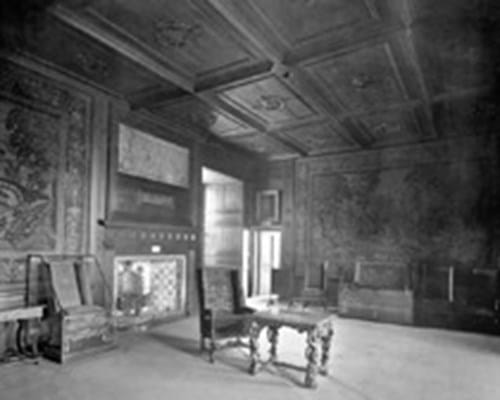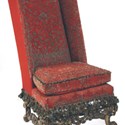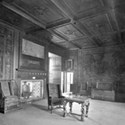The myths linking the late 17th century furnishings at Holyroodhouse with 16th century events begin in the 1740s when the architect William Adam redecorated the first floor of the tower in the latest Georgian taste.
The more baroque furnishings, including beds ordered in the late 17th century, were moved upstairs to the second floor apartments of the oldest portion of the palace where they were only seen by the occasional antiquarian anxious to set eyes upon 'Queen Mary's apartments' and what Sir Walter Scott dubbed "the couch of the Rose of Scotland".
In the hands of an imaginative 19th century tour guide (by tradition the housekeeper was entrusted with showing visitors the second floor rooms), it was perhaps only natural that each object in the room should somehow be woven into the story of the Martyr Queen and the brutal murder of David Rizzio that took a tenacious hold on popular taste in the Victorian era. Properly stage-managed, Mary Queen of Scot's Bedchamber at Holyrood became the most famous room in Scotland, and the esteem in which this chair came to be held can be seen in early 20th century photographs, one illustrated here, where it and another were enclosed in glazed cases.
It was not until 1903 that Sir Herbert Maxwell, then president of the Society of Antiquaries of Scotland, significantly altered and rearranged these rooms in a manner that, if less inviting to the Edwardian tourist, was more fitting for an abandoned suite of furniture from the 1680s.
But, romantic notions of the Martyred Queen aside, this is nonetheless a rare survival of aristocratic parade furniture from the period between the Restoration and the abolition of the Scottish Parliament. It was almost certainly one of several pieces of furniture commissioned for Holyrood between 1682 and 1694 by its new resident, William, 3rd Duke of Hamilton. Doubtless he was in a celebratory mood - in the same year he was invested as a Knight of the Garter, the 486th such member - so he took the opportunity to update his new private residence, expanding into the James V Tower rooms, and furnishing in the style of the day.
John Ridge, a London upholsterer, charged £218 10s for "a crimson and gould velvet bett, loyned with satin with eight chairs and velvet cases, a feather bed and bolster, quilts, Japanned glass and stands a footstool blankets…".
The giltwood chair - while compromised by later restoration it retains much of its original 17th century silver thread needlework - is ornately carved to the front apron with the Most Noble Order of the Garter motto Honi Soit Qui Mal y Pense (Evil/Shamed be he that thinks evil) carved into a central belt.
It is probable that the chair - and a giltwood settee with both the garter and the cypher of the Duke of Hamilton carved into the cresting, still at Holyrood - stands as a manifestation of the pride the 3rd Duke felt in becoming a member of one of the oldest and noblest orders. Certainly it evokes the wealth and power of the Scottish nobility during this period. There is very little comparable furniture in private hands in Scotland.
In the family of Dukes of Hamilton for more than three centuries, and latterly residing in their East Lothian home Lennoxlove, the chair was consigned for sale at Edinburgh saleroom Lyon and Turnbull on March 29.
The estimate was £60,000-80,000 and happy to tender the lower figure to ensure the chair remained North of the Border was the National Museums of Scotland.
Stephen Jackson, curator of Applied Art and Design at the museums, said the chair will join other important items associated with the Dukes of Hamilton (who were Hereditary Keepers of the Palace during the late 17th and 18th centuries), including the Hamilton Palace Drawing Room of 1701, and a silver-gilt part tea service made for the Emperor Napoleon by Martin-Guillaume Biennais in 1810 and acquired by the 10th Duke in 1830.
The Art Fund and the Lindsay Endowment, administered by NMS Charitable Trust, provided much of the funding.
An associated late 17th century japanned armchair, probably one of a set of four from "my Lady's Bedchamber" recorded in a 1684 Holyrood inventory, was estimated at £30,000-40,000 but failed to sell.
By Roland Arkell
The myth of Scotland’s royal seat
It gives some idea as to how furniture connoisseurship has changed that the upholstered high-back chair pictured here could once have been accepted as an original furnishing from the bedroom of Mary Queen of Scots.








